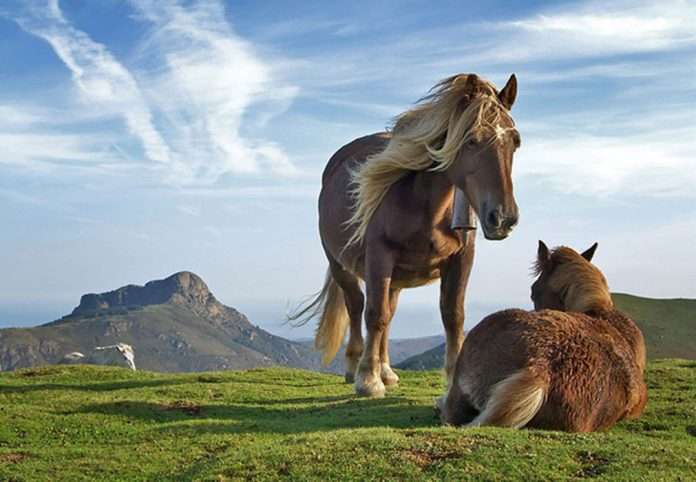The Horse is a one toed hoofed mammal. It is usually a domesticated animal. The Horse has evolved over the past 45 to 55 million years from a multi toed creature, Eohippus into the large Single toed animal of today. The Zoological name of Horse is Equips ferrous cabalas. Since 4000 BC Horse has become domesticated. There are wild horses also. They are called feral horses.
Horses are born to run. They quickly escape predators and process an excellent souse of balance and a strong fight or flight response. Horses are able to sleep both standing position and lying down. The young horses sleep longer than their parents. Female horses are called mares, who carry their young for eleven months. A young horse called foal, can stand and run as soon as it gets birth. Horse becomes adult after five years. Horse has lifespan of 25 to 30 years only.
Horses and humans interact in myriad ways battle, agriculture, police work, entertainment, therapy etc. Since ancient times horses are used in warfare’s, even in both the epic battles-Ramayan and Mahabharat. Even the British Sahibs used horses for battles. Alexander, the great, Rana Pratap had their favourite horses.
Prince Sidhartha, left home on horse back to become a Sanyasi who is better known as Gautama Budha. Varieties of riding and driving techniques developed using many different styles of equipment and methods of control. In the examination of British civil services there was a test of horse riding in which Sri Aurovindo failed.
Many products are derived from horses meat, milk, hair, bone and medicines extracted from the urine of pregnant mares. Humans provide food, water, and shelter and veterinary doctors for attention in case of illness and injury. Horses are named differently in their different stages of life.
1. Foal – A child horse less than one year old.
2. Yearling – between one and two years old.
3. Colt – A male horse under the age of four.
4. Filly – A female horse under the age of four.
5. Mare – A female horse four years old and older.
6. Stallion – A non castrated male horse four years old and older. The term horse means stallion.
7. Gelding – A castrated male horse
Studies have indicated that horses perform a number of cognitive tasks on a daily basis. Like food procurement, identification of Individuals within a social system, good spatial discrimination, problem solving, speed of learning, memory, Horses are naturally curious and apt to inquire things they have not seen before. Horses excel at simple learning. But also able to use advanced cognitive abilities like categorisation, concept learning, habituation, desensitisation, classical conditioning and operant conditioning.
Since ancient times humans have intrinsic relation with horse. Now we have no Alexander and his Bucephalus horse, we have no Rana Pratap and his chetak horse, we have no Gautama Budha and his Kanthaka Horse. In ancient times kings were performing Aswamedha Yajna.
At last, I will tell a story of Horse. Long ago there was a prose piece – my Breaking in matriculation course. There was a mother horse and her child horse. They were leading a happy life under an owner. Time came when the child horse was sold out. At the time of departure the mother horse advised her child horse –
“My son do better wherever you are and keep up your good name”.
(The views expressed are the writer’s own.)

Radhakanta Seth is a former Income tax officer in Sambalpur. He is a freelance writer and his articles have been published in some Oriya dailies like Sambad, Samaj, Dharitri, and English dailies like The Telegraph and in a sociological journal ‘Folklore’ published in Kolkata.
He can be reached at [email protected]

